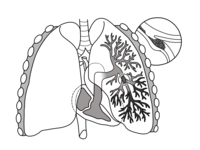
Photo from wikipedia
Background Pulmonary embolisms are frequently and prognostically in individuals infected by coronavirus disease 2019 (COVID-19); the incidence of pulmonary embolisms is varied across numerous studies. This study aimed to assess… Click to show full abstract
Background Pulmonary embolisms are frequently and prognostically in individuals infected by coronavirus disease 2019 (COVID-19); the incidence of pulmonary embolisms is varied across numerous studies. This study aimed to assess the pooled incidence of pulmonary embolic events and the prognostic value of such events in intensive care unit (ICU) admissions of patients with COVID-19. Methods The Cochrane Library, PubMed, and EmBase were systematically searched for eligible studies published on or before October 20, 2021. The pooled incidence of pulmonary embolism was calculated using the random-effects model. Moreover, the prognostic value was assessed by measuring the sensitivity, specificity, positive and negative likelihood ratio (PLR and NLR), diagnostic odds ratio (DOR), and the area under the receiver operating characteristic curve (AUC). Results Thirty-six studies involving 10,367 COVID-19 patients were selected for the final meta-analysis. The cumulative incidence of pulmonary embolism in patients with COVID-19 was 21% (95% confidence interval [95%CI]: 18−24%; P<0.001), and the incidence of pulmonary embolism in ICU and non-ICU patients was 26% (95%CI: 22−31%; P<0.001) and 17% (95%CI: 14−20%; P<0.001), respectively. The predictive role of pulmonary embolism in ICU admission was also assessed, and the sensitivity, specificity, PLR, NLR, DOR, and AUC were 0.31 (95%CI: 0.21−0.42), 0.84 (95%CI: 0.75−0.90), 1.88 (95%CI: 1.45−2.45), 0.83 (95%CI: 0.75−0.91), 2.25 (95%CI: 1.64−3.08), and 0.61 (95%CI: 0.57−0.65), respectively. Conclusion This study found that the incidence of pulmonary embolism was relatively high in COVID-19 patients, and the incidence of pulmonary embolism in ICU patients was higher than that in non-ICU patients.
Journal Title: PLoS ONE
Year Published: 2022
Link to full text (if available)
Share on Social Media: Sign Up to like & get
recommendations!